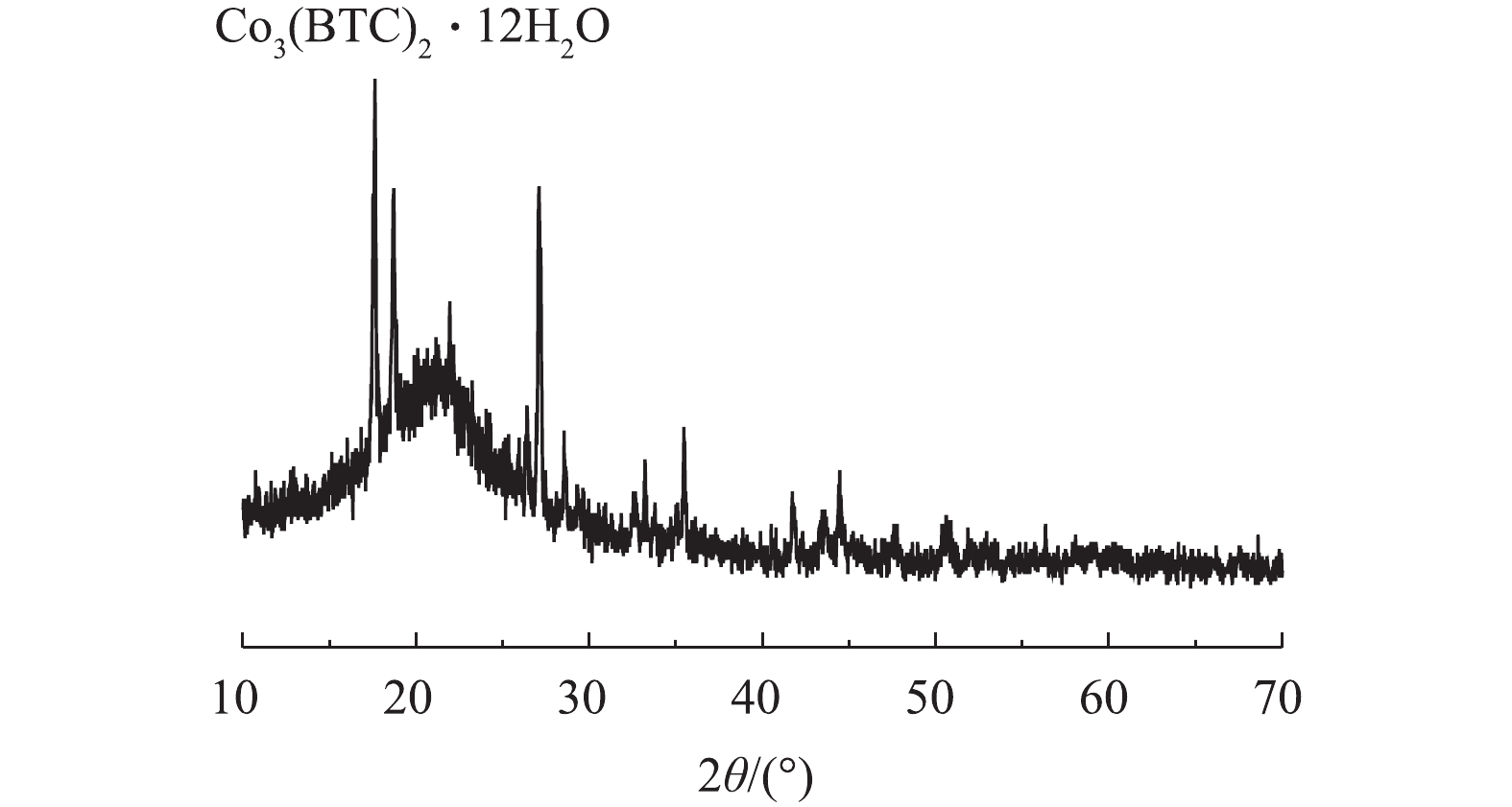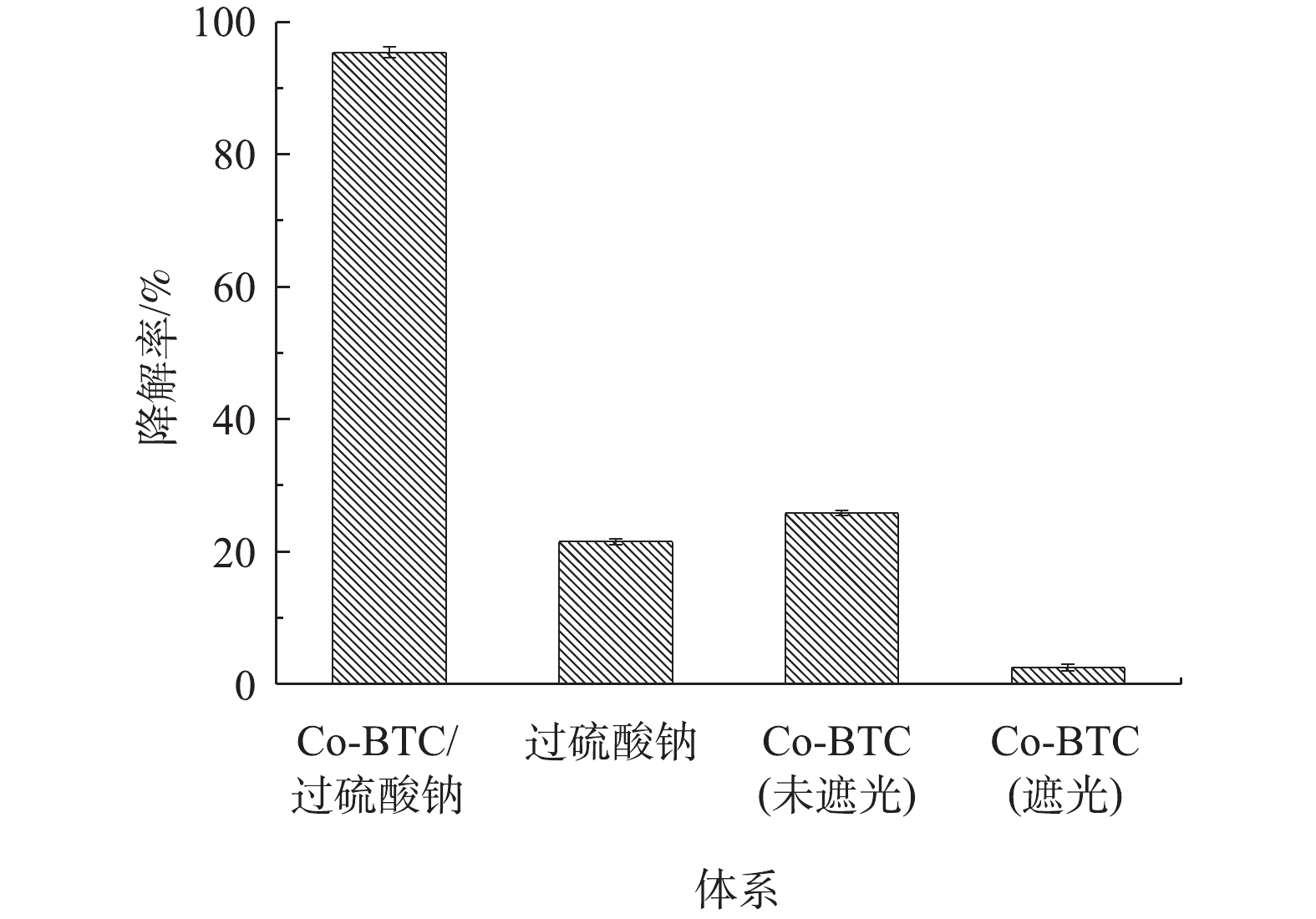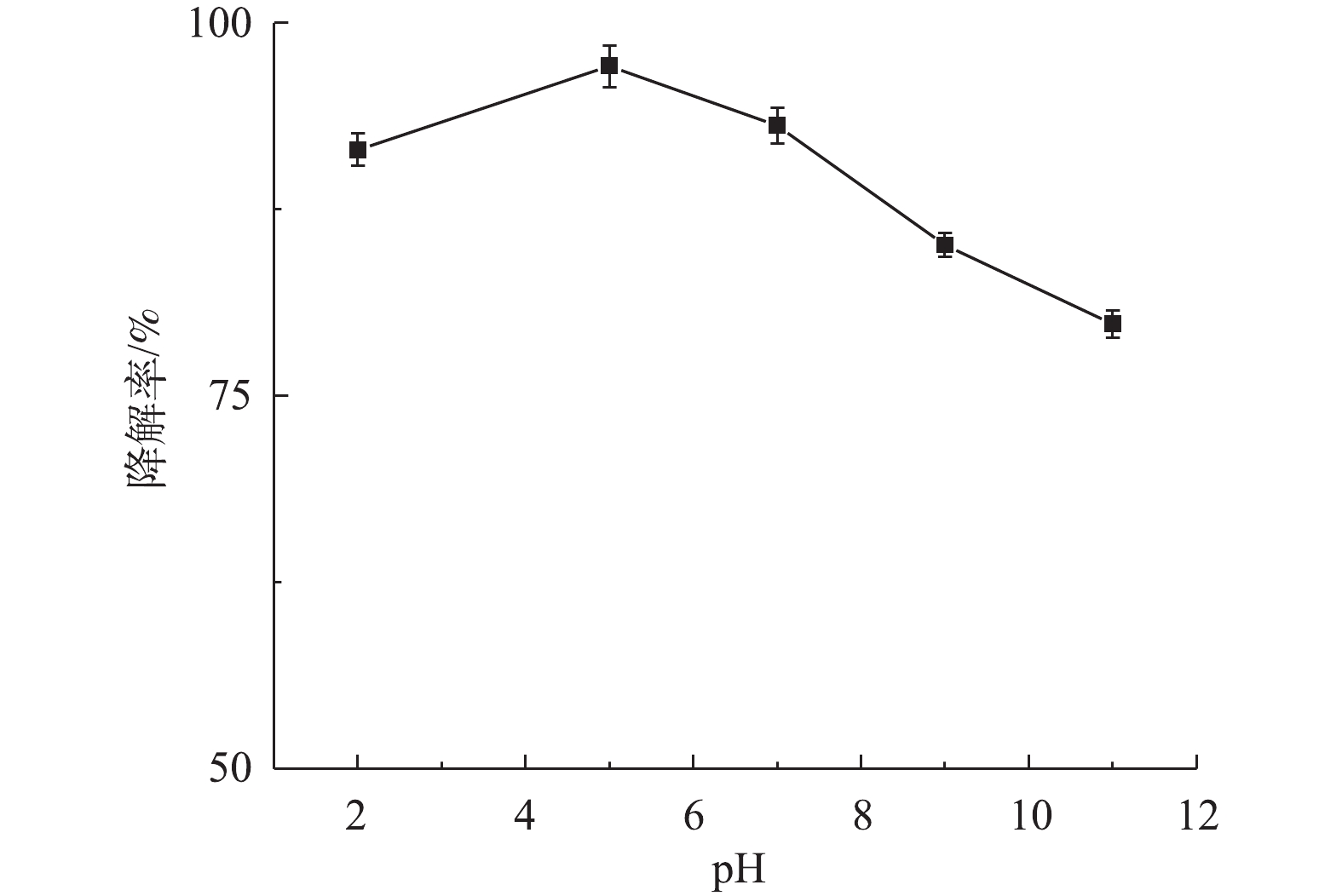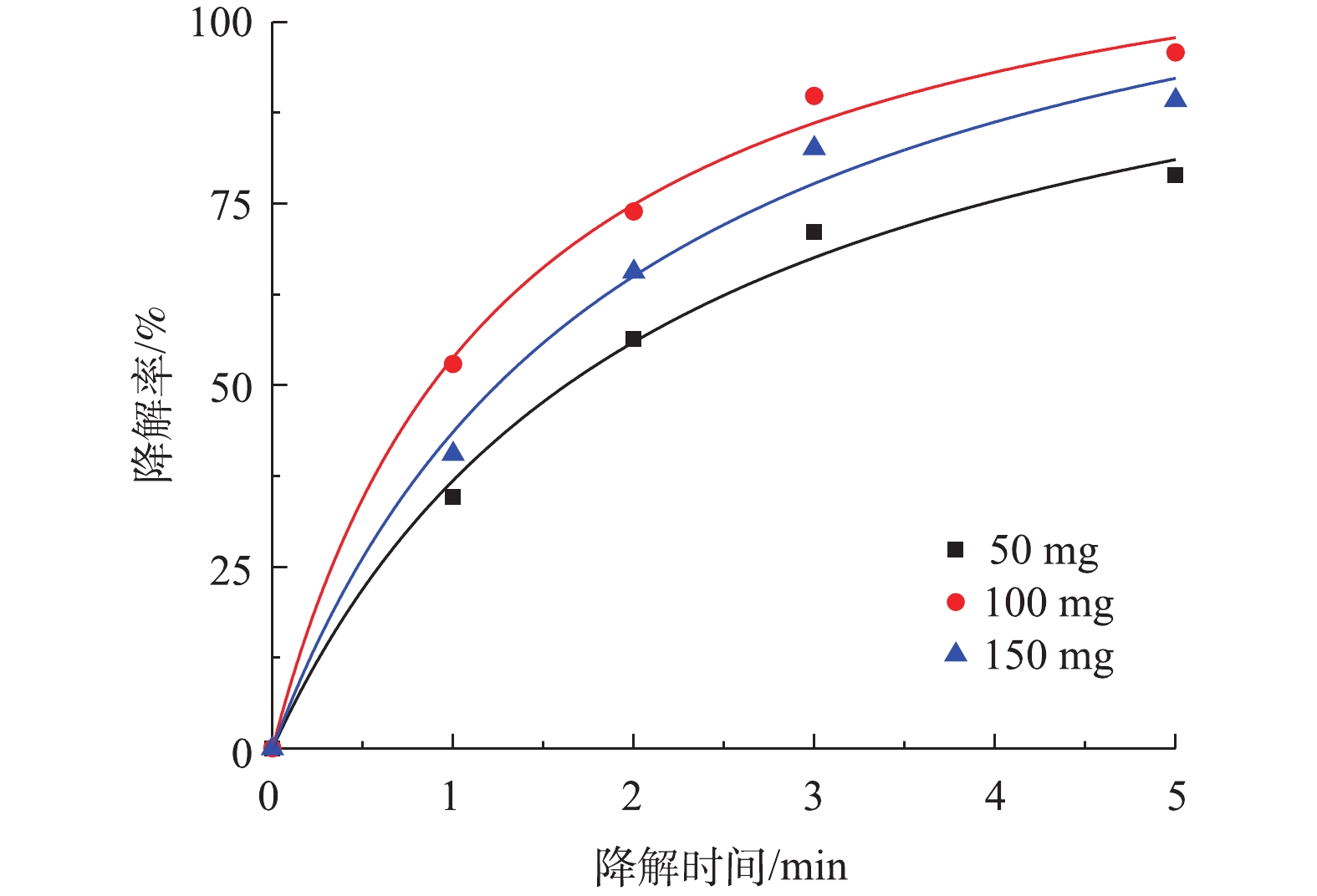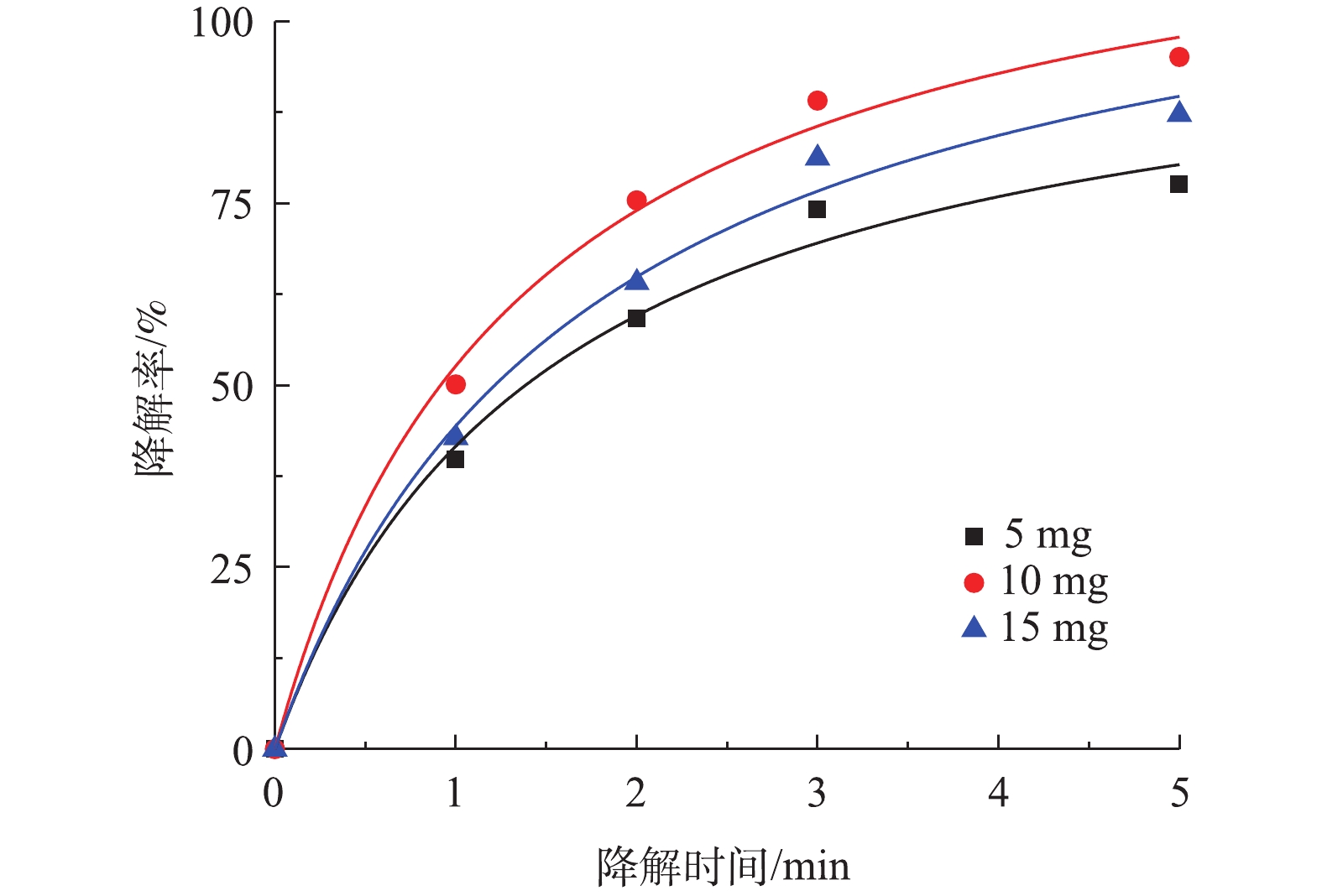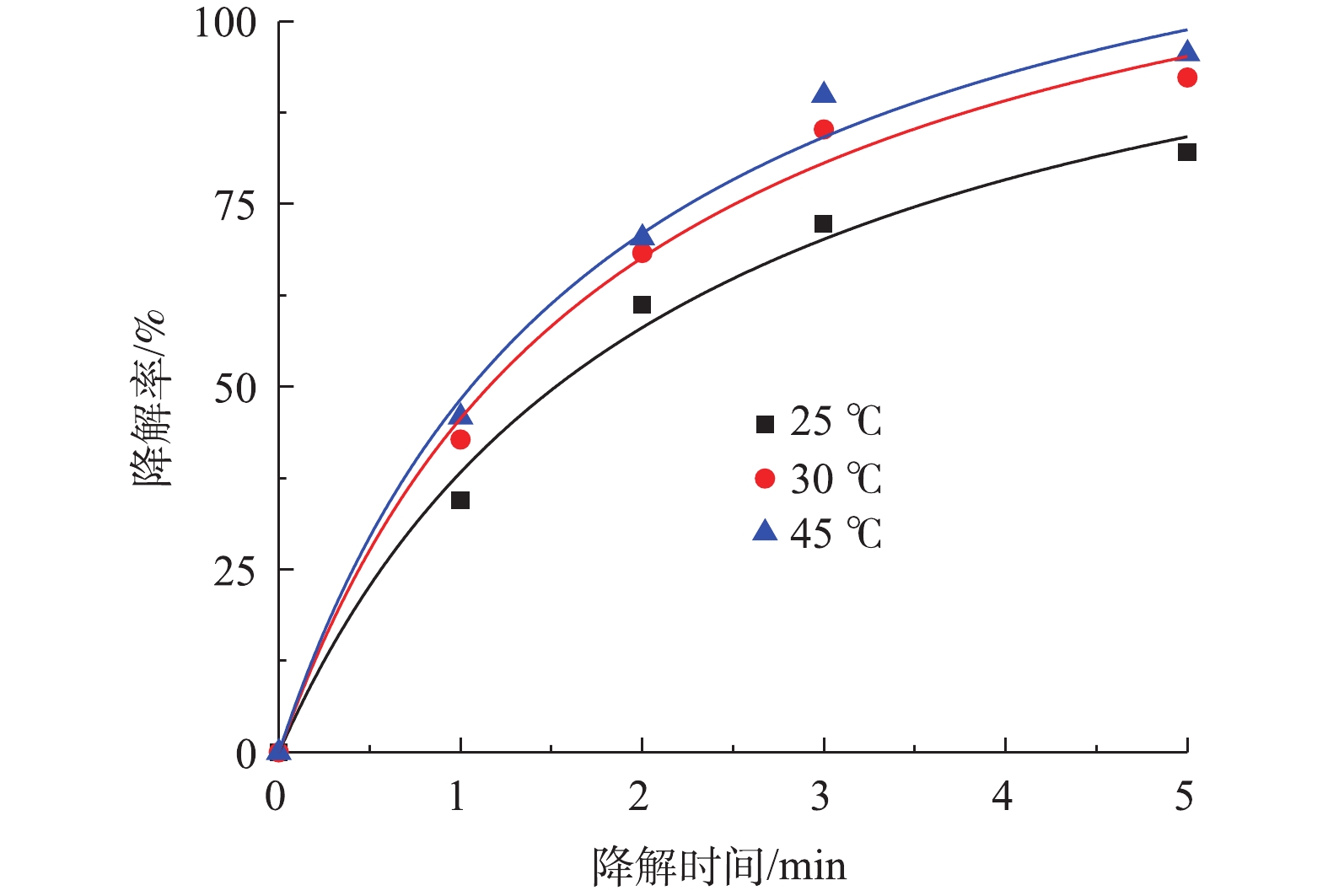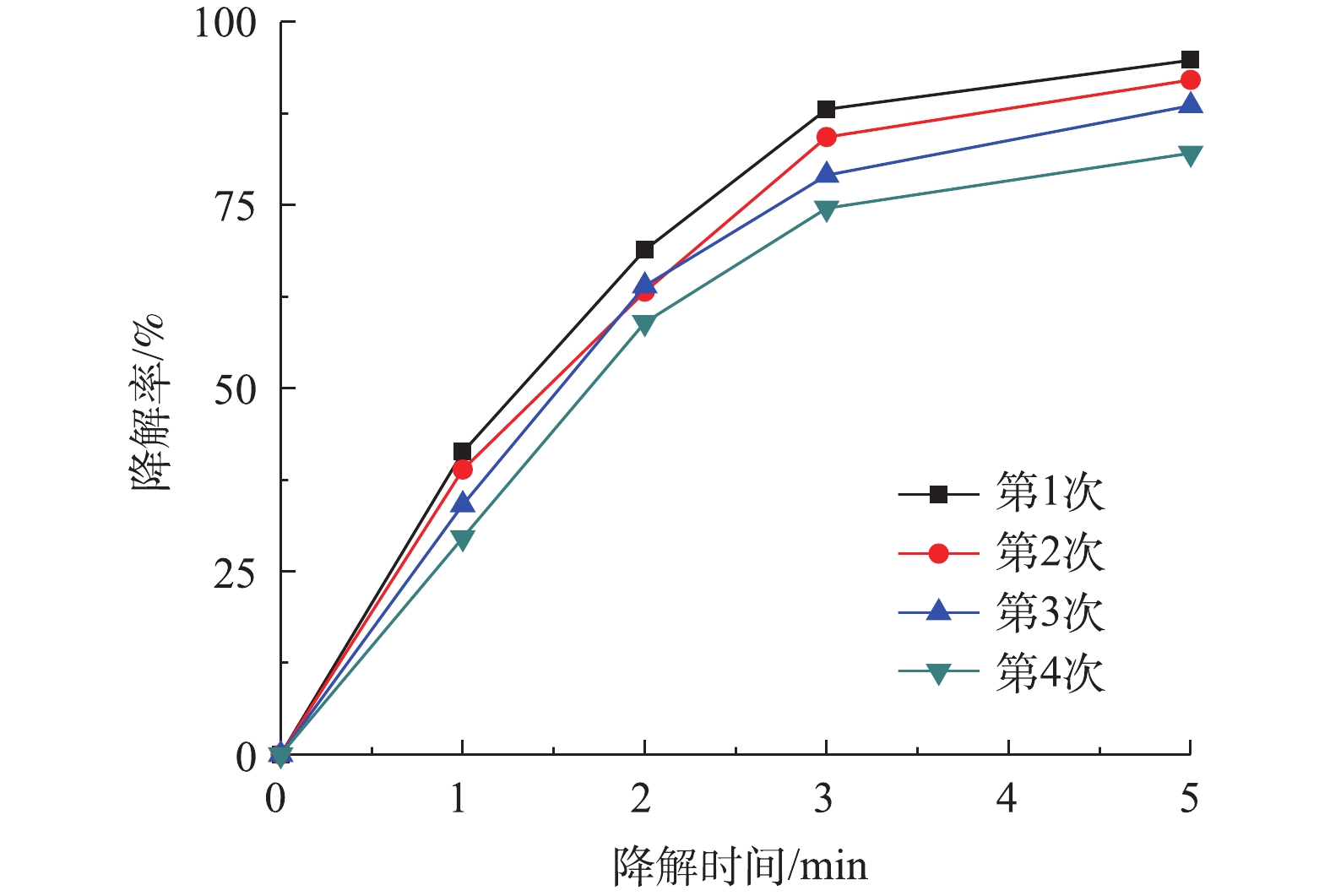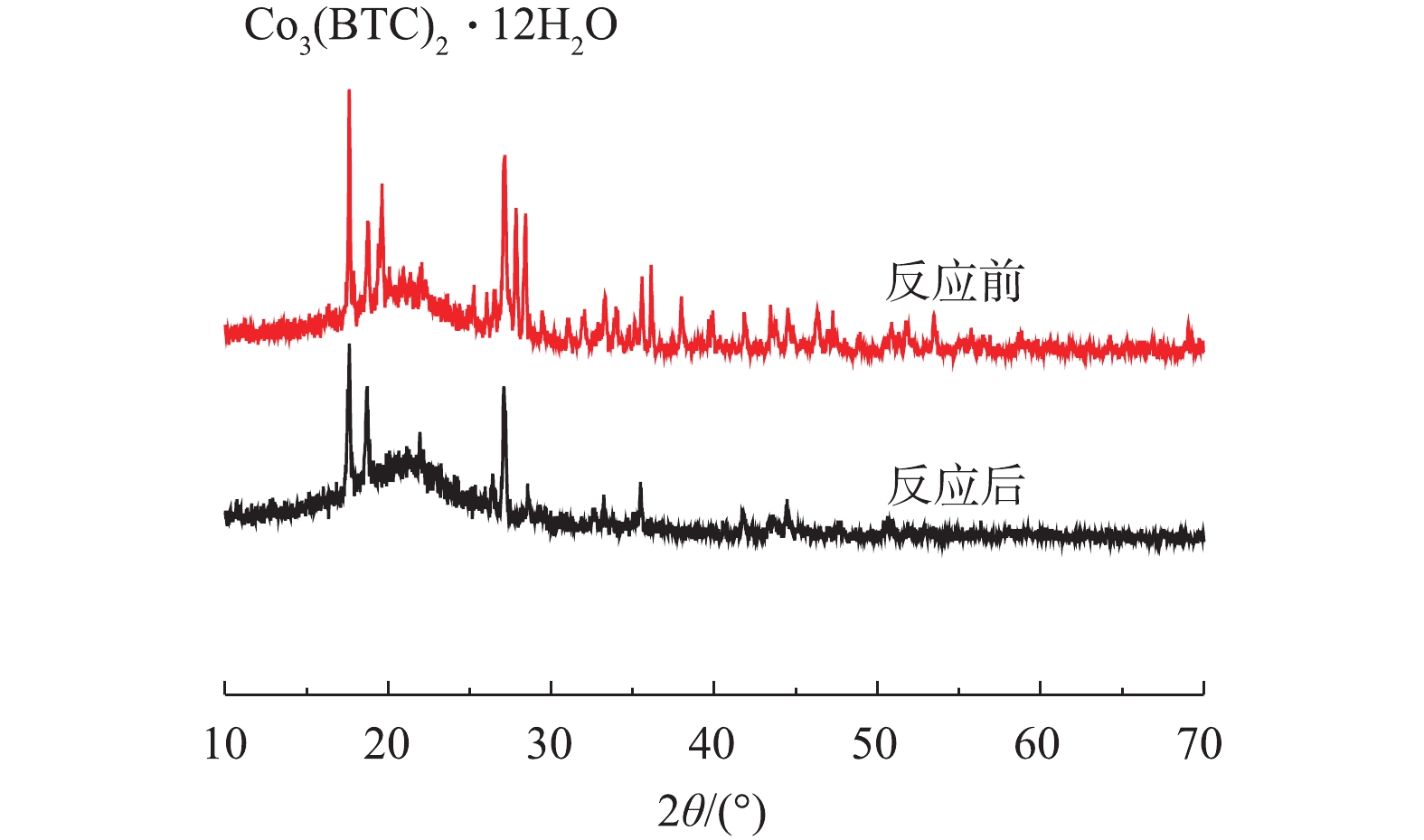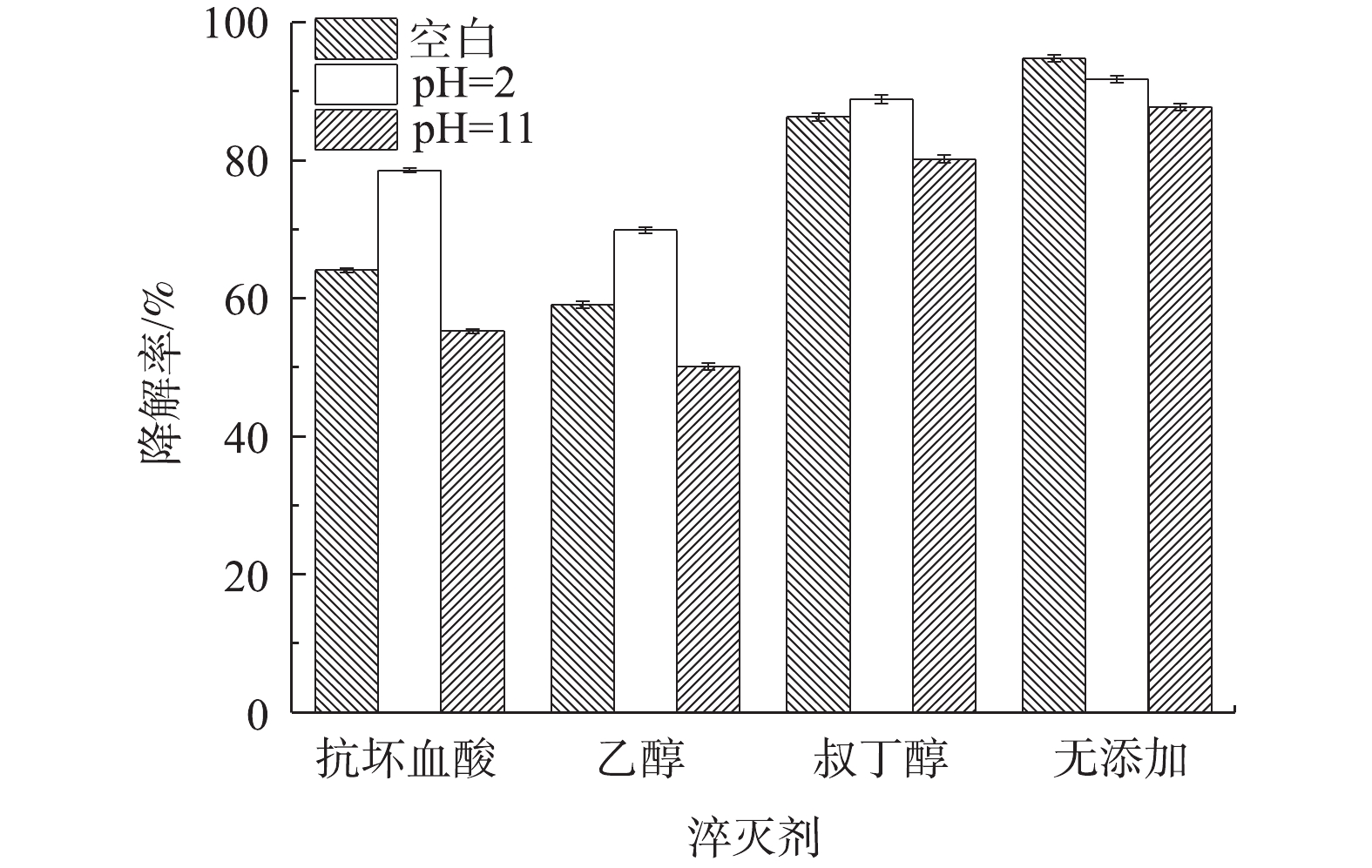柠檬酸改性竹纤维吸附剂的制备
Preparation of bamboo fibers adsorbent modified by citric acid
-
摘要: 采用预处理和柠檬酸酯化反应2个阶段的处理方法对竹纤维进行修饰改性,考察了预处理溶液浓度、预处理时间、柠檬酸用量比、催化剂用量比、热反应时间,热反应温度对改性效果的影响,并测定了改性后竹纤维材料对重金属Ni2+的吸附性能。实验结果表明,当预处理溶液浓度取5%,预处理时间控制在180 min,柠檬酸用量比取20 mmol·g-1,催化剂次磷酸钠用量比取0.4,热反应时间控制在90 min,热反应温度为120℃时,改性效果达到最佳,得到的最高羧基团含量为3.373 mmol·g-1。改性后的竹纤维材料对Ni2+的吸附容量高达9.486 mg·g-1,相比未改性的竹纤维,吸附性能上有显著提升。Abstract: Bamboo fiber, a highly efficient absorbing material, was modified by pretreatment and esterification with citric acid. The parameters that affect the carboxyl group content and adsorption capacity of Ni2+ ions, such as the pretreatment solution concentration, pretreatment time, catalysts/bamboo weight ratio, CA/bamboo amount ratio, reaction temperature, and reaction time were examined. The experimental results showed that the optimum modified conditions were 5% pretreating solution concentration, 180 min pretreatment time, 20 mmol·g-1 CA/bamboo amount ratio, 40% sodium hypophosphite, 90 min reaction time, and 120℃ reaction temperature. The products in the above-mentioned modified conditions showed significantly increased adsorption capacity, with the carboxyl group content and the maximum adsorption capacity being 3.373 mmol·g-1 and 9.486 mg·g-1, respectively.
-
Key words:
- pretreatment /
- citric acid /
- bamboo fibers /
- modification /
- adsorption
-
近年来,抗生素的广泛使用导致其以不同的方式大量流入环境[1-2],其中包括盐酸土霉素。盐酸土霉素属于一种广谱抗菌素,在养殖业和农业中作为杀虫剂普遍使用,但是其很难被生物体完全吸收,盐酸土霉素的部分代谢产物及大量的残留会进入环境中,危害环境并给人类带来危害风险[3]。目前,针对抗生素的废水处理方法有水解、生物降解、高级氧化法等,其中,水解和生物降解均有耗时长、耗资大等缺点。高级氧化法是目前研究最为广泛一种废水处理方法,包括有芬顿氧化法[4-5]、光催化氧化法[6]和电化学氧化法[7-8]等。
高级氧化法主要利用具有强氧化性功能的羟基自由基(·OH)或硫酸根自由基(
SO⋅−4 )与废水中的目标污染物发生反应,氧化降解污染物并使其矿化。近年来,运用SO⋅−4 [9]的高级氧化技术逐渐成为热门,跟·OH[10-11]比较发现,SO⋅−4 具有较低的氧化还原电势(2.60 V),而且SO⋅−4 的使用寿命比·OH要更长久,能在降解污染物的同时保持节能和高效[12-14]。常规的高级氧化催化剂的催化活性较低,其中,一种新颖的金属-有机骨架材料(metal-organic frameworks, MOFs)引起人们广泛的关注。MOFs因其具有高比表面积、高稳定性和高孔隙率的特点被频繁运用。如PENG等[15]和ZHANG等[16]研究基于MOFs的新型材料MIL-53(Al)和H-UiO-66s对各类废水有机污染物的捕获时发现,MIL-53(Al)和H-UiO-66s均对有机污染物产生高效的吸附和去除,这表明MOFs具备去除污染物的性能。另外,MON等[17]和胡龙兴等[18]研究MOFs对水体污染的修复效果的结果表明,MOFs能有效的降解有机污染物。本研究采用水热法制备Co-MOF催化剂,并对其物化性质进行了表征。同时,考察了Co-MOF活化PS降解盐酸土霉素的性能及重复利用效果,并进一步对该降解反应的机理进行分析。1. 材料与方法
1.1 试剂和仪器
实验试剂:均苯三甲酸(GR,上海化学)、三乙胺(GR,国药控股)、六水合硝酸钴(AR,国药控股)、叔丁醇(CP,国药)、抗坏血酸(AR,国药)、盐酸土霉素(国药);其他试剂均为国药分析纯试剂,实验用水为去离子水。
实验仪器:KH-100型Teflon-lined反应釜(北京瑞昌伟业)、pHS-3C型pH计(上海仪电科学)、UV1900型紫外可见分光光度计(上海佑科)、SHA-C型水浴恒温振荡箱(常州澳华)、ZA3300型火焰原子吸收分光光度计(北京日立)。
1.2 实验方法
1) Co-MOF的制备。量取25 mL去离子水于烧杯中,加入1.45 g Co(NO3)2•6H2O、1.05 g均苯三甲酸和2 mL三乙胺,再将烧杯放置在磁力搅拌器上搅拌15 min,然后将溶液转移到Teflon-lined反应釜中,密封放置在190 ℃的电热鼓风干燥箱中24 h。将反应后所得离心(6 000 r·min−1)2 min获取沉淀物,用乙醇和去离子水各反复冲洗3次,再60 ℃真空烘干备用。
2) Co-MOF降解盐酸土霉素的实验。量取20 mg·L的盐酸土霉素于反应器中,加入一定量的Co-MOF和PS,在恒温震荡箱中反应5 min,特定时间取样,并用紫外分光光度计在353 nm波长处测定吸光度,根据标准曲线计算盐酸土霉素反应后的浓度。实验结束后收集定量的上清液,加入适量硝酸酸化至pH≤2,然后用火焰原子吸收分光光度计测定其中的钴含量。盐酸土霉素的降解率按照式(1)进行计算。
η=(C0−Ce)C0×100% (1) 式中:
η 为盐酸土霉素的降解率;C0和Ce分别为盐酸土霉素溶液初始浓度和平衡时的浓度,mg·L−1。2. 结果与讨论
2.1 Co-MOF表征
1)扫描电镜(SEM)和透射电镜(TEM)。通过SEM、TEM和EDS对制备的Co-MOF的形貌特征、粒径以及组成成分进行分析。如图1(a)和图1(b)的SEM表征所示,Co-MOF是由棒状晶体组成,每个棒状晶体的长度大约几百微米,宽约为30~100 μm,这与YAGHI等[19]的报道结果相似。如图2所示,Co-MOF含有C、O和Co元素,其中,Co元素的相对峰面积占比较大,这表明Co在Co-MOF结构中的重要性。如图1(c)和图1(d)的TEM表征所示,可见Co-MOF是由棒状晶体组成,并且每个棒状晶体表面平滑、多孔隙,这与PATTERSON等[20]的研究结果类似。
2)X射线衍射(XRD)。通过XRD对制备的Co-MOF结构进行分析。如图3所示,在17.5°附近有明显的衍射峰,此峰对应Co3(BTC)2·12H2O的晶面(014),故这表明Co(NO3)2·6H2O和均苯三甲酸发生完美融合,这与以往报道[21-22]中的Co-MOF的XRD图谱相似。
2.2 不同体系对盐酸土霉素的降解效果
图4为不同催化剂反应体系下盐酸土霉素的降解效果对比。由图4可见,在第1组(未遮光)和第2组(遮光)中,单独的Co-MOF添加对盐酸土霉素的降解率分别为25.8%和3.9%,这是Co-MOF自身的光催化特性导致,如孙登荣等[23]研究MOFs材料的光催化性能时发现,MOFs具有光催化性能。在第3组实验中,单独的PS添加对盐酸土霉素的降解率为21.5%,这是由于PS的热活化反应导致。杨世迎等[24]开展的活化过硫酸盐高级氧化技术的研究结果表明,在热、光、过渡金属等外在条件的催化下,过硫酸盐均能通过吸收能量来使内部构造发生变化。在第4组实验中,Co-MOF/PS对盐酸土霉素的降解率为95.4%。这样的结果与预期一样,表明Co-MOF具有高效活化PS的性能。
2.3 影响Co-MOF降解盐酸土霉素的因素
1) pH对盐酸土霉素降解的影响。图5为不同pH对盐酸土霉素降解的影响。如图5所示,盐酸土霉素在pH=2.0~11.0时均有不同程度的降解,其中,当pH=5.0时,对盐酸土霉素的降解率最高为97.1%。当pH=2.0、3.0、9.0和11.0时,对盐酸土霉素的降解率分别为91.5%、93.1%、85.3%和79.8%,这与预估一致,一方面是由于
SO⋅−4 和·OH在pH≤3时与H+发生反应引起的(式(2)和式(3)),导致SO⋅−4 和·OH被清除;另一方面是由于SO⋅−4 与OH−和水发生反应引起的(式(4)和式(5)),导致SO⋅−4 被转化为·OH。⋅OH+H++e−→H2O (2) SO4⋅−+H++e−→HSO4− (3) SO4⋅−+OH−→SO22−+⋅OH (4) SO4⋅−+H2O→SO22−+OH+H+ (5) 2) PS投加量对盐酸土霉素降解的影响。由图6可知,当PS添加量为从50 mg增加到100 mg时,对盐酸土霉素的降解率从78.9%上升到95.8%,这表明盐酸土霉素的降解率随着PS投加量的增加而变大。而PS投加量达到150 mg时,对盐酸土霉素的降解率下降,原因是由于过多的PS会使
SO⋅−4 量超过临界值,使SO⋅−4 被PS捕获清除[25]。根据图6中拟合曲线结果,Co-MOF活化PS降解盐酸土霉素的动力学曲线符合准二级动力学模型,50 mg和100 mg PS添加量对应的的拟合曲线中R2分别为0.992 6和0.995 6,而150 mg PS添加量的拟合曲线中的R2最低为0.989 3,由于100 mg PS添加量的拟合曲线中R2高于50 mg添加量,所以确认本研究中最佳PS投加量为100 mg。3) Co-MOF投加量对盐酸土霉素降解的影响。由图7可知,5 mg Co-MOF添加量对盐酸土霉素的降解率为77.6%,10 mg Co-MOF添加量对盐酸土霉素的降解率为95.1%,而15 mg Co-MOF添加量对盐酸土霉素的降解率为87.2%,这表明随着Co-MOF投加量的增加,盐酸土霉素去除率呈现先增后减的趋势。造成这种情况的原因是:一方面是由于过多的
SO∙−4 会产生自我清除反应;另一方面由于过多的Co-MOF会增加溶液内的浊度。根据图7中拟合曲线结果,Co-MOF活化PS降解盐酸土霉素的动力学曲线符合准二级动力学模型,其中5 mg Co-MOF添加量的曲线拟合度R2最小为0.989 6,而10 mg和15 mg Co-MOF添加量的曲线拟合度R2分别为0.993 7和0.992 0,由于10 mg Co-MOF添加量的拟合曲线中的R2最高,所以确定本研究中最佳Co-MOF投加量为10 mg。4)温度对盐酸土霉素降解的影响。图8为不同反应温度对盐酸土霉素降解的影响。如图8所示,在25 ℃时,对盐酸土霉素的降解率有82.1%;在30 ℃时,对盐酸土霉素的降解率上升到92.3%;而当45 ℃时,对盐酸土霉素的降解率高达95.6%。这表明随着反应温度的升高,对盐酸土霉素的降解率也随之增大。在Co-MOF/PS体系中,
SO⋅−4 的生成不仅被Co-MOF的活化性能影响,还被温度影响。随着温度的增加,加快体系中PS的热激活行为,加速电子转移,使PS的O—O键更易于断裂,SO⋅−4 的生成更多更快,从而提高对盐酸土霉素的降解率。以往的报道[26-27]也证实这点,如刘红梅等[28]开展的热活化过硫酸盐降解土壤和地下水中污染物的研究发现,当温度过低时并不能对过硫酸盐进行有效的活化并生成SO∙−4 ,反而在升温过程中SO⋅−4 的生成速率会加快,进而促进盐酸土霉素的降解;但当温度过高时也会受到抑制影响,原因是由于自由基被高温清除。龙安华等[29]关于活化过硫酸盐降解水污染的研究结果也表明,在热活化过硫酸盐的过程中,随着温度的变化,pH、离子强度及有机质耗氧等也会产生相应的改变,所以温度会影响到污染物的降解率。根据图8的结果可见,Co-MOF活化PS降解盐酸土霉素的动力学曲线符合准二级动力学模型,其中30 ℃的曲线拟合度R2最高为0.991 0,故确定30 ℃为本次研究的最佳反应温度。2.4 Co-MOF重复利用对降解盐酸土霉素的影响
催化剂的稳定性是检验催化剂性能的重要指标,图9为Co-MOF重复利用对降解盐酸土霉素的影响。如图9所示,Co-MOF第4次运行后,对盐酸土霉素的降解率下降为82.1%,这表明Co-MOF具备较高的稳定性。其中,导致盐酸土霉素降解率降低的原因是:一方面由于Co-MOF活化PS降解盐酸土霉素时,长时间浸泡导致Co(Ⅱ)的活性位点损失;另一方面是由于Co2+随着多次循环出现微量损失(式(6))。第4次运行结束后收集定量的上清液,经检测显示钴含量为1×10−4 mg·L−1,而国标(GB 25467-2010)中的钴排放标准为总钴含量≤1 mg·L−1,故本次研究中Co-MOF的使用不会对环境造成二次污染。
Co2++S2O82−→SO4⋅−+SO42−+Co3+ (6) 2.5 反应机理
1) Co-MOF降解盐酸土霉素反应前后的XPS表征。通过XPS对Co-MOF降解盐酸土霉素反应前后的组分变化进行分析。图10为Co-MOF反应前后的XPS图谱。如图10(a)所示,Co-MOF材料的宽扫描光电子能谱呈现Co2p、O1s和C1s 3个光谱图。在Co2p核心级XPS光谱中(图10(b)),反应前的Co2p1/2和Co2p3/2的结合能对应781.4 eV和800.4 eV;在786.2 eV的峰值是由辅峰造成的,由Co的sp3杂化所形成。有研究[30]表明,在低结合能一侧的781.4 eV若是归属于Co(Ⅱ),就表明Co在材料中的主要存在状态是Co(Ⅱ)氧化态,其在pH=2时没明显变化,而在pH=11时Co2p1/2对应的强度明显增强,这表明Co-MOF在酸性条件下更稳定。由图10(a)可知,在pH=11时反应后的Co2p的峰值有所升高,这是由于碱性条件下Co3+被还原为Co2+所致(式(7))。图10(c)显示的是O1s的光谱,反应前和当体系的pH=2反应后的结合能峰均为532.4 eV,表明CO-MOF中的羧基没有受到损坏,结合C1s的XPS光谱中(图10(d))的数据,其结合能没有发生明显的变化。综上所述,Co-MOF具有良好的稳定性。
Co3++OH−→3/2Co2++H−+1/2O2 (7) 2) Co-MOF降解盐酸土霉素反应前后的XRD表征。如图11所示,在Co-MOF降解盐酸土霉素反应完成后,XRD图谱中Co3(BTC)2·12H2O对应的峰强度降低,这表明Co-MOF材料在降解盐酸土霉素的过程中有损失。
3)自由基淬灭剂对Co-MOF降解盐酸土霉素的影响。为了确定Co-MOF活化PS所产生的自由基种类,采用自由基捕获实验以验证活化体系中可能存在的自由基。众所周知,抗坏血酸和乙醇均为·OH和
SO⋅−4 的淬灭剂,而叔丁醇仅为·OH的淬灭剂。如图12所示,加入叔丁醇的实验组中,盐酸土霉素的降解率与无添加组相比有微弱下降,而加入抗坏血酸和乙醇的实验组中,盐酸土霉素的降解率无添加组相比大幅度下降,这表明在对盐酸土霉素降解的实验过程中同时涉及到SO⋅−4 和·OH,且SO⋅−4 是起主导作用的。在pH=2的条件下,加入抗坏血酸、乙醇和叔丁醇后,相比较空白条件,盐酸土霉素的降解率反而得到提升,加入叔丁醇的实验组对盐酸土霉素的降解率的提升效果微弱,这表明·OH在酸性条件下更易于生成,如陈震等[31]研究溶液pH对·OH的影响时发现,酸性环境更易于·OH的生成。当pH=11时,在加入淬灭剂后,发现对于盐酸土霉素降解效果的抑制明显高于空白条件下,原因是由于碱性环境有利于·OH的去除。3. 结论
1) SEM、TEM和XRD的表征结果表明,采用水热法成功制备出Co-MOF。该催化剂具有较好的降解性能,在Co-MOF浓度为200 mg·L−1、PS浓度为2 000 mg·L−1时,5 min后Co-MOF/PS对盐酸土霉素的降解率达到95.4%。
2) Co-MOF投加量、PS投加量和温度对Co-MOF降解盐酸土霉素有较大的影响,pH对降解盐酸土霉素的影响不大。其中,当pH=5、温度30 ℃、Co-MOF浓度为200 mg·L−1、PS浓度为2 000 mg·L−1时,Co-MOF/PS对盐酸土霉素的降解率可达到最高。
3)重复利用Co-MOF降解盐酸土霉素结果表明,Co-MOF具有可重复利用性能。Co-MOF反应前后的XRD和XPS数据表明,Co-MOF具有良好的稳定性。自由基捕获结果表明,在该降解反应过程中,
SO⋅−4 和·OH对盐酸土霉素的降解均有贡献,其中,SO⋅−4 的贡献最大。 -
[1] HE Mingxiong, WANG Jingli, QIN Han, et al. Bamboo: A new source of carbohydrate for biorefinery. Carbohydrate Polymers,2014, 111: 645-654 [2] 窦营, 余学军, 岩松文代. 中国竹子资源的开发利用现状与发展对策. 中国农业资源与区划,2011, 32(5): 65-70 DOU Ying, YU Xuejun, FUMIYO I. The current situation and countermeasures of bamboo resource development and utilization of China. Chinese Journal of Agricultural Resources and Regional Planning,2011, 32(5): 65-70(in Chinese) [3] 周益权, 耿养会, 蒋宣斌, 等. 重庆竹资源开发利用现状与发展对策. 竹子研究汇刊,2011, 30(3): 58-61 ZHOU Yiquan, GENG Yanqui, JIANG Xuanbin, et al. The situation of exploitation and utilization and countermeasures for the development of bamboo industry in Chongqing. Journal of Bamboo Research,2011, 30(3): 58-61(in Chinese) [4] OUYANG Xiaokun, JIN Ru'na, YANG Leping, et al. Bamboo-derived porous bioadsorbents and their adsorption of Cd(II) from mixed aqueous solutions. RSC Advances,2014, 54(4): 28699-28706 [5] 方润, 陈云平. 竹屑基吸附材料的制备及吸附行为研究. 纤维素科学与技术,2013, 21(4): 15-22 FANG Run, CHEN Yunping. Preparation and adsorption performance of bamboo-based dye adsorbent. Journal of Cellulose Science and Technology,2013, 21(4): 15-22(in Chinese) [6] GUO Doudou, PAN Hao, LIU Hailu, et al. Ultrasonic wave-assisted preparation of bamboo powder-based adsorbents for Pb2+ removal. Chemistry and Industry of Forest Products,2013, 33(6): 1-6 [7] 龚新怀, 许琪琛, 林维晟. 竹屑基吸附材料的制备及其吸附亚甲基蓝的研究. 宿州学院学报,2012, 27(8): 56-59 GONG Xinhuai, XU Qichen, LIN Weisheng. Preparation and adsorption of bamboo sawdust-based adsorbent to methylene blue. Journal of Suzhou University,2012, 27(8): 56-59(in Chinese) [8] 朱国营, 陈萍萍. 壳聚糖改性竹制粉末活性炭吸附剂对微囊藻毒素的吸附特性研究. 环境科学学报,2012, 32(4): 790-795 ZHU Guoying, CHEN Pingping. Adsorption characteristics of microcystin-RR by a synthetic powdered bamboo charcoal mixed with chitosan. Acta Scientiae Circumstantiae,2012, 32(4): 790-795(in Chinese) [9] LI Qingzhu, CHAI Liyuan, WANG Qingwei, et al. Fast esterification of spent grain for enhanced heavy metal ions adsorption. Bioresource Technology,2010, 101(10): 3796-3799 [10] SAJAB M. S., CHIA C. H., ZAKARIA S., et al. Citric acid modified kenaf core fibres for removal of methylene blue from aqueous solution. Bioresource Technology,2011, 102(15): 7237-7243 [11] HAN Runping, ZHANG Lijun, SONG Chen, et al. Characterization of modified wheat straw, kinetic and equilibrium study about copper ion and methylene blue adsorption in batch mode. Carbohydrate Polymers,2010, 79(4): 1140-1149 [12] MARSHALL W. E., AKIN D. E., WARTELLE L. H., et al. Citric acid treatment of flax, cotton and blended nonwoven mats for copper ion absorption. Industrial Crops and Products,2007, 26(1): 8-13 [13] ZHU Bo, FAN Tongxiang, ZHANG Di. Adsorption of copper ions from aqueous solution by citric acid modified soybean straw. Journal of Hazardous Materials,2008, 153(1/2): 300-308 [14] PEHLIVAN E., ALTUN T., PARLAYICI Š. Modified barley straw as a potential biosorbent for removal of copper ions from aqueous solution. Food Chemistry,2012, 135(4): 2229-2234 [15] LEYVA-RAMOS R., LANDIN-RODRIGUEZ L. E., LEYVA-RAMOS S., et al. Modification of corncob with citric acid to enhance its capacity for adsorbing cadmium(II) from water solution. Chemical Engineering Journal,2012, 180: 113-120 [16] WANG Shuaiyang, WANG Linping, KONG Weiqing, et al. Preparation, characterization of carboxylated bamboo fibers and their adsorption for lead(II) ions in aqueous solution. Cellulose,2013, 20(4): 2091-2100 [17] ZHAO Shuna, BAIK O. D., CHOI Y. J., et al. Pretreatments for the efficient extraction of bioactive compounds from plant-based biomaterials. Critical Reviews in Food Science and Nutrition,2014, 54(10): 1283-1297 [18] YAMASHITA Y., SHONO M., SASAKI C., et al. Alkaline peroxide pretreatment for efficient enzymatic saccharification of bamboo. Carbohydrate Polymers,2010, 79(4): 914-920 [19] 林瑾, 余少文, 王娟. 不同溶剂对玫瑰花粉内壁破壁的影响. 食品科技,2008(10): 54-56 LIN Jin, YU Shaowen, WANG Juan. The effect of different reagents on the inner-wall breaking of rose pollen. Food Science and Technology,2008(10): 54-56(in Chinese) [20] REN Junli, SUN Runcang, PENG Feng. Carboxymethylation of hemicelluloses isolated from sugarcane bagasse. Polymer Degradation and Stability,2008, 93(4):786-793 期刊类型引用(2)
1. 杜纪富,董珍,杨鑫,赵龙. 竹纤维电子束辐射接枝及其磷的静态和动态吸附. 辐射研究与辐射工艺学报. 2021(03): 18-27 .  百度学术
百度学术
2. 代发文,林涛,苏保元,霍小东,尕尔让拉么,杨瑶君. 断奶仔猪纤维营养应用研究进展. 中国饲料. 2021(15): 58-63 .  百度学术
百度学术
其他类型引用(3)
-

 点击查看大图
点击查看大图
计量
- 文章访问数: 2698
- HTML全文浏览数: 2277
- PDF下载数: 698
- 施引文献: 5






 下载:
下载:

